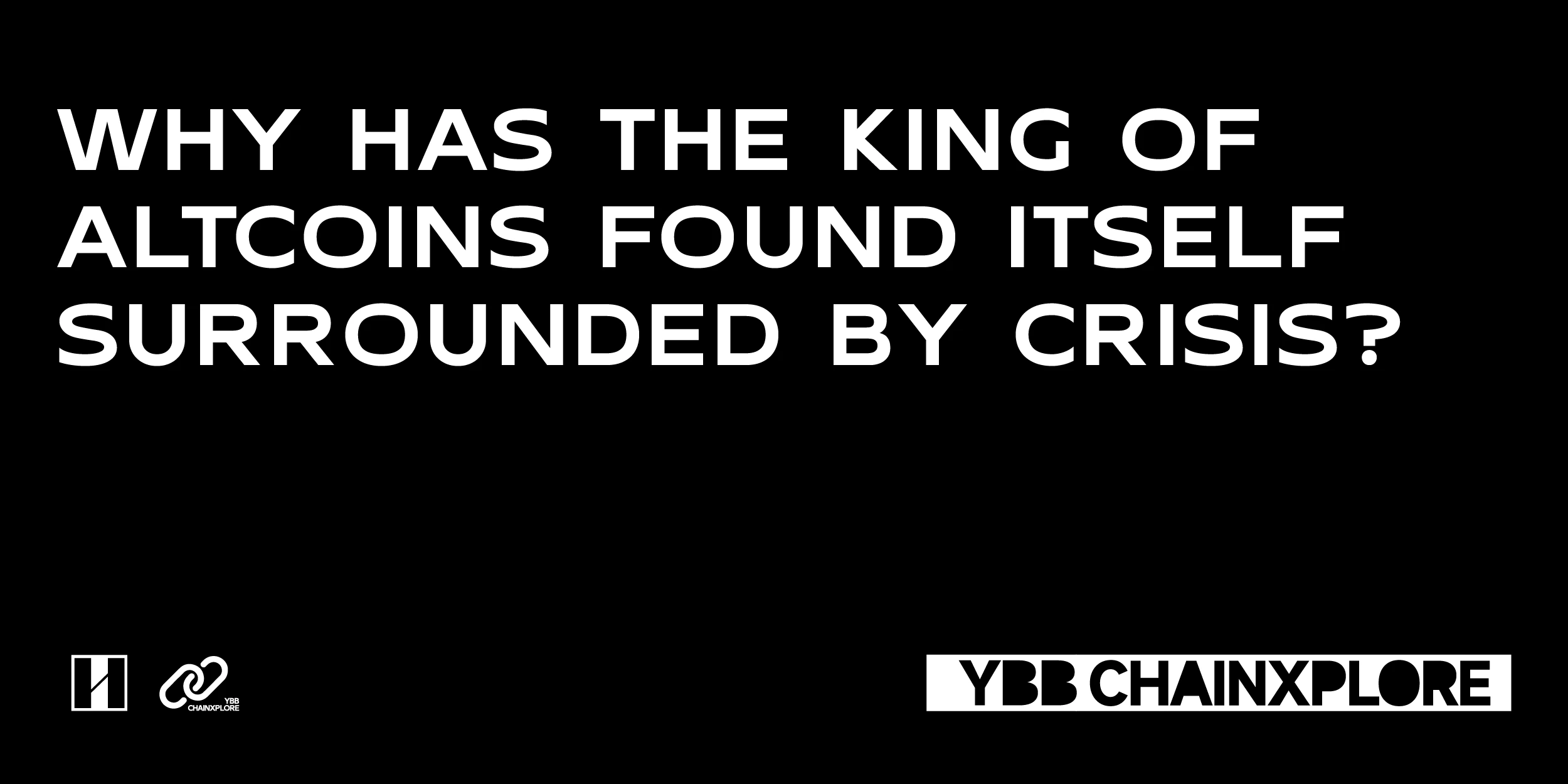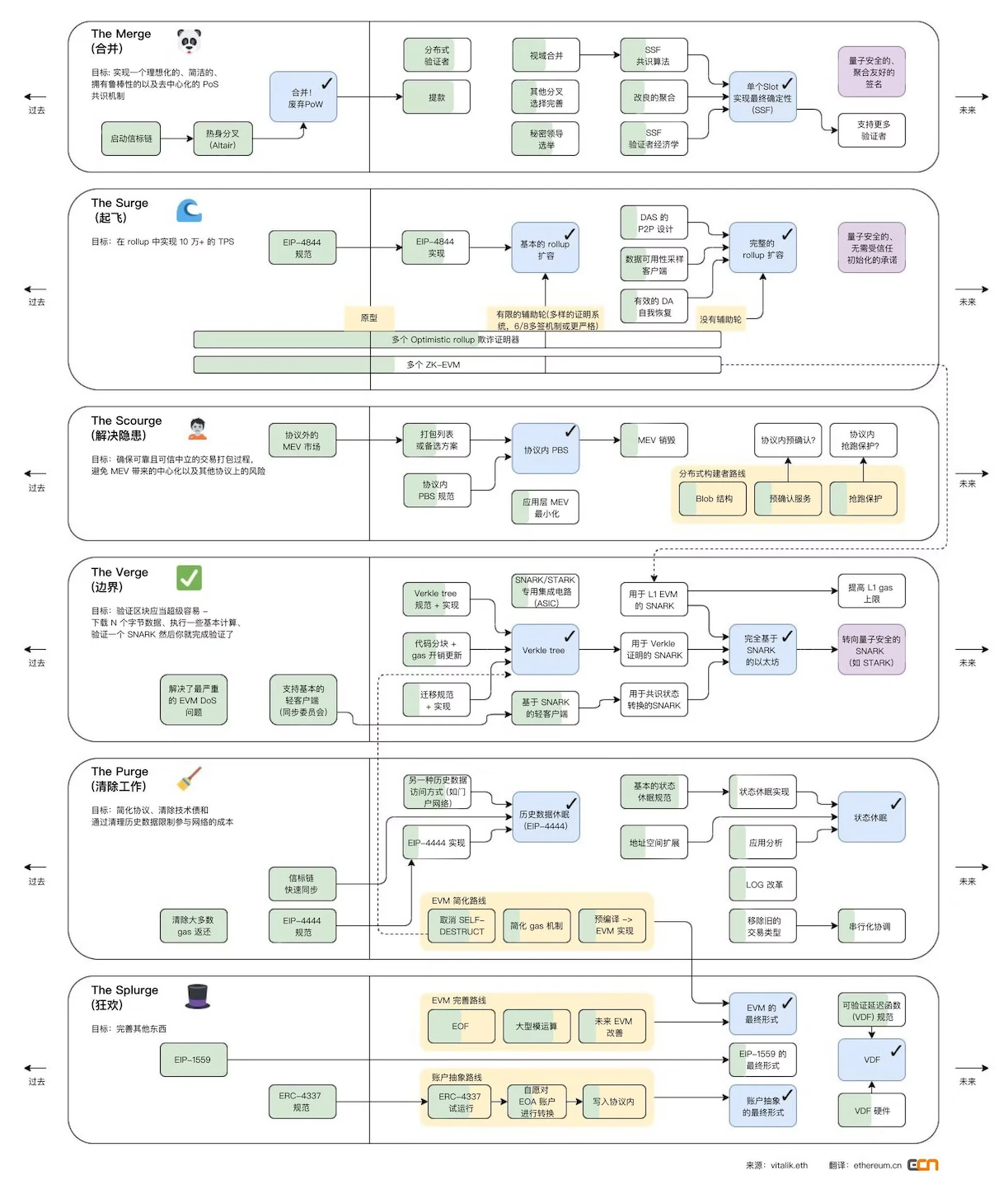المؤلف الأصلي: الباحث زيكي من شركة YBB Capital
مقدمة
The halving law began to fail, and a large number of copycats also became sluggish. Speculators are withdrawing, and believers are beginning to doubt themselves. The despair of the industry comes not only from the low prices in the secondary market, but also from confusion about the future direction. Criticism has begun to become the main theme in the circle, from the lack of applications to the details in the financial reports of major public chains. Now, the spearhead has begun to point to Ethereum, the former hot spot of encryption. So, what is the internal dilemma of the king of copycats?
1. Expand the main chain horizontally and create multiple layers vertically
The expansion towards fully modularization is Vitaliks vision for the end of Ethereum in 2018 and 2019. That is, the bottom layer is optimized around Data Availability, and the upper layer is infinitely expanded, thus escaping the public chain triangle paradox, and Ethereum becomes the settlement layer of all chains, and finally realizing the end game of blockchain expansion game.
After confirming the feasibility of the concept, the roadmap of Ethereum began to advance rapidly. In 2023, with the successful merger of the main chain and Beacon Chain in the Shanghai upgrade, the main theme of modularization began to cover the Ethereum ecosystem. Now, after the Cancun upgrade, the first step towards EIP 4844 has been taken. The main chain itself has been infinitely close to Vitaliks idea in his early years. Its upper layer is also flourishing, and Gas, TPS, and diversity are gradually crushing former opponents. It can be said that except for the disadvantage of the sense of separation, all heterogeneous chains narratives about Ethereum Killer should be declared over. But the cruel reality is that TON and Solana are constantly rising, and many Infra projects that plagiarize modular narratives are even better than the modular main supported by ETFs in the secondary market. What is the reason for this situation?
The transition from POS to Layer 2 is the main focus of recent criticism of Ethereums crimes, but in my opinion, Ethereum developers and Vitalik have done nothing wrong in promoting modularization. If there is any, it may be that the process is pushed too fast and too idealistic. I wrote a paragraph in an article at the beginning of the year, which roughly means: If blockchain has a lot of application value outside the financial field, and Mass Adoption will eventually come, then Ethereums shift to modularization will make sense. Obviously, Ethereum is too idealistic in this regard, and there is currently no evidence to prove that these two points are real. The same is true for the pricing curve of DA. With the current status of Layer 2, the imagined application layer explosion has not arrived. Secondly, there are basically only ARB, OP, and Base, the top streams of a large number of general chains that are still active. It is impossible to satisfy Ethereums positive cycle by relying solely on DA income. There are still many remaining problems. For example, Gas consumption has been reduced by dozens or even hundreds of times. Things that once required the purchase of 0.1 ETH can now be done with only 0.001 ETH, and user activities have not increased by dozens or hundreds of times, making the market supply far greater than demand. However, it seems right to promote the development of public chains towards large-scale adoption while maintaining decentralization and security to the maximum extent. Ethereum has been able to gradually turn the pie it has been drawing for eight years into reality, which is already precious in the crypto world. Unfortunately, reality is utilitarianism first, and the market will not pay for ideals. In the current situation of lack of applications and liquidity, the contradiction between technical idealists and investors will continue to deepen.
2. Human Nature
Ethereums idealism is not only reflected in the judgment of the future of the application layer, but also in the judgment of human nature. Currently, there are two most hotly debated issues in Layer 2: 1. Centralized Sequencer; 2. رمز مميز. From a technical point of view, Layer 2 can be decentralized. But from a human point of view, it is impossible for the top Layer 2 projects to hand over the huge profits brought by the sequencer. Unless the three words of decentralization can activate the token and achieve greater benefits. For example, the several top Layer 2s just mentioned are of course fully capable of decentralizing the sequencer, but they will not do so. Because they are all top-down projects that have been burned through huge financing, their birth method is very Web2, and so is their operating logic. The relationship between community members and Layer 2 is more like the relationship between consumers and cloud server operators. For example, those who often use Amazons AWS servers may receive some coupons and cash back, and the same is true for Layer 2 (airdrop). But the income from the sequencer is the lifeblood of Layer 2, from the perspective of the project party. Design, financing, development, operation, hardware purchase, each link does not require community support. In their logic, users do not contribute much (this is why many Layer 2 project parties always have a bad attitude towards users), not to mention that the community wants to decentralize the sequencer. Morality alone cannot constrain Layer 2. If you want to decentralize the sequencer as much as possible, you have to design a new sequencer solution from the perspective of the interests of the Layer 2 project party, but obviously this solution will be very controversial. A better approach is to erase the decentralized Sequencer part of the roadmap, or put it in an invisible place on the roadmap. Todays Layer 2 is completely contrary to Ethereums original intention of embracing modularity. Most Layer 2s are just stealing concepts and dividing up everything valuable in Ethereum.
Lets talk about Tokens. The public chain of Layer 2 is still a new product in encryption. From the perspectives of Ethereum, Layer 2 project parties, and the community, the existence of Tokens is very contradictory. Lets talk about it in order. From the perspective of Ethereum, there should be no Tokens in Layer 2. Layer 2 is just a high-performance expansion server that needs to be used across chains for Ethereum. It only charges user service fees, which is healthy for both parties. Only by maintaining the value and status of ETH to the maximum extent can the business be carried out for a long time. To put it in a more concrete way, if the entire second-layer ecosystem is compared to the European Union, then maintaining the stability of the euro is necessary. If a large number of member states are issuing their own currencies to weaken the euro, then the European Union and the euro will eventually cease to exist. Whats more interesting is that Ethereum does not restrict the issuance of Layer 2 coins, nor does it restrict whether Layer 2 should use ETH as a gas fee. This open attitude in terms of rules is indeed very Crypto. However, with the continued weakening of ETH, EU members are ready to move. In the top Layer 2 chain-issuing tools, it is basically clearly marked that projects can use any token as Gas, and projects can choose any integrated DA solution. In addition, one-click chain-issuing will also lead to the birth of a small alliance on the second layer.
On the other hand, from the perspective of Layer 2 and the community, even if ETH rebounds strongly in the future, Token鈥檚 situation is still very embarrassing. As for issuing coins, the top Layers were actually very hesitant in the early days. In addition to the problems mentioned above that are in opposition to ETH, there are also the following points: regulatory risks, no need to maintain development through tokens if there is no shortage of money, the scale of token empowerment is difficult to make, and direct use of ETH can promote TVL and ecological growth the fastest. Issuing tokens by yourself may conflict with this matter, and liquidity cannot be stronger than ETH.
It is still a question of human nature. No one can refuse to print billions of banknotes out of thin air. Furthermore, from the perspective of community members and ecological development, Tokens seem to be supposed to exist. In this way, in addition to charging a fixed service fee, there is also a treasury that can be cashed out at any time. Why not? However, the design of Tokens should be combined with the above problems to minimize empowerment. As a result, a bunch of air tokens that do not need to be pledged through POS and mined through POW were born. Their functions are only voting, and each linear release will also divide a large amount of liquidity from the market. As time goes on, these undriven Tokens will continue to fall after a one-time airdrop. Neither the community nor the investors can give a good explanation, so should they be empowered? Any valuable empowerment will conflict with the above problems and eventually fall into a dilemma. The status of the tokens of the four kings can also well illustrate the above problem.
Base, which does not issue tokens, is now much more prosperous than Zks and Starknet, and its sorter income has even exceeded that of OP, the creator of Superchain. This has been mentioned in previous articles about the attention economy. Borrowing social media influence, operations, and pull-ups to create the wealth effect of MEME and multiple projects in the ecosystem is actually an indirect multiple small airdrops, which is much healthier than directly issuing coins and then airdropping them all at once. In addition to creating continuous attraction, it can also avoid a lot of problems. Allocating a portion of the sorter income every month can keep it active and build a healthy ecosystem. In addition, the current Web3 points gameplay is just the surface of PDD. Coinbase is far better than upstarts like Tieshun in the way of steady and long-term operation.
3. Inferior Competition
The first layer is homogenized with the second layer, and the second layer is also homogenized with the second layer. This situation stems from a very critical problem. In this round, there are not many independent applications that can support an application chain, and the few that can support it have run away (DYDX). From the current situation, it can be said that the target users of all Layer 2 are the same, and even the same as the main chain. An extremely bad phenomenon has also arisen from this. The second layer is constantly eroding Ethereum, and there is a vicious competition between the second layer and the second layer for TVL. No one understands the difference between these chains. Users can only rely on the points activity to determine where to store money today and where to swipe transactions. Homogeneity, fragmentation, and lack of liquidity. In the public chain ecosystem of Web3, Ethereum is currently the only one that can occupy the above three points at the same time. These problems also stem from the disadvantages brought about by the open spirit of Ethereum itself. We may soon see a large number of Layer 2 being naturally eliminated, and the centralization problem will also cause various chaos.
4. The leader does not understand Web3
Whether it is the former V God or the Little V in the mouth of KOLs now, Vitaliks contribution to infrastructure has indeed promoted the prosperity of the entire circle since the Satoshi era, which is obvious to all. However, the reason why Vitalik is now called Little V is not only because of his private life, but also because of a very interesting argument that the Ethereum leader does not understand DApp, let alone DeFi. I agree with this statement to a certain extent, but before continuing to discuss this issue, I would like to make one thing clear first. Vitalik is Vitalik, and only Vitalik. He is not an omnipotent god, nor is he a dictator who is useless. In my eyes, Vitalik is actually a relatively humble and active public chain leader in work and study. If you have read his blog, it should not be difficult to find that he updates one to three discussions on philosophy, politics, Infra, and DApp every month, and is also happy to share on Twitter. Compared with some public chain leaders who like to criticize Ethereum from time to time, Vitalik is much more pragmatic.
After saying the good things, lets talk about the negative side. In my opinion, Vitalik has three problems:
1. He has a huge influence on this circle, from retail investors to VCs. Everyone is influenced by his words and deeds. To Vitaliks entrepreneurship is also a pathological trend for Web3 projects;
2. He is very persistent in the technical direction he is optimistic about, and sometimes even supports it;
3. He may really not understand what crypto users need.
Lets start with Ethereums expansion. The argument that Ethereum urgently needs to expand is often supported by the ultra-high on-chain access brought about by the overflow of external liquidity in 21-22 years. But every time Vitalik talks about this, he seems to really not understand that this is obviously a short-term phenomenon, and why users come to the chain. Another point is that he has repeatedly emphasized the technical superiority of ZK on Layer 2, but ZK is obviously not so friendly in terms of user experience and ecological development. Nowadays, a large number of ZK Rollups started by To Vitalik, not to mention the T 2 and T 3 echelons, even the two top kings are on the verge of death, and the performance of the three giants of Optimistic Rollup is better than the sum of dozens of ZK Rollups. There are some other problems like this. For example, in the middle of last year, the criticism of the MPC wallet was biased and directly supported the AA wallet. Earlier, SBT was proposed, but it was so useless in application that no one mentioned it later. It can be said that the technical solutions supported by Vitalik in recent years have not performed well in the market. Finally, his recent remarks on DeFi are also confusing. In many aspects, it can only be said that Vitalik is not perfect. He is an excellent and idealistic developer, but at the same time he lacks understanding of the user group and occasionally expresses subjective opinions on things that he does not understand deeply enough. The industry needs to demystify him and distinguish right from wrong in the controversy about him.
5. From Virtual to Real
From the ICO boom in 2016 to the P2E bubble in 2022. In the history of infrastructure being limited by performance and constantly developing, each era will have its own Ponzi schemes and emerging narratives, thus pushing the industry towards a bigger bubble. We are currently experiencing an era of bubble bursting, with huge financing projects self-destructing, high-sounding narratives failing again and again, and a gap in the value of Bitcoin and copycats. How to do valuable things is the main point that I will continue to output in many articles this year. From virtual to real is also the current main trend. When Ethereum embraces modularization, many people say that the narrative of Ethereum killers should be turned over. But now the hottest ecosystems are TON and Solana. Do they have any innovations that change Crypto? Are they more decentralized or secure than Ethereum? None, and there is no innovation in the narrative. They just make those things that sound mysterious more like applications, and integrate the advantages of the chain into a level closer to Web2, thats all.
With the internal volume growing exponentially and the external liquidity lacking, efforts to find new narratives are also not enough to fill the block space of Ethereums second layer. As the industry leader, Ethereum should first solve the fragmentation and internal corruption of the second layer. In particular, why did the Ethereum Foundation (EF), which was not mentioned above, not play a role that matches it despite the massive squandering of funds? Why should infrastructure funding still be given the highest priority when the second layer infrastructure is extremely oversupplied? Even the leader of Cex is lowering his profile and seeking change. EF, as a key organization to accelerate the growth of the ecosystem, is going in the opposite direction.
This article is sourced from the internet: Why is the king of copycats surrounded by enemies?
Related: Crypto سوق Sentiment Research Report (2024.08.16–08.23): Bitcoin rises as dovish turn to impending rate cut
Bitcoin rises as dovish stance turns to imminent rate cut At 10 a.m. Eastern Time on Friday, August 23, Federal Reserve Chairman Powell made an important speech at the Jackson Hole Global Central Bank Annual Meeting. **It is worth noting that Powell stated quite clearly: The time for policy adjustment has come. The policy direction is clear, and the timing and pace of interest rate cuts will depend on subsequent data, changes in the outlook and the balance of risks. Some analysts said that although Powell confirmed the markets widespread expectation of starting interest rate cuts in September, this speech was also dovish, providing a certain clarity to the financial market in the short term, but did not provide many clues about how the Fed will act after the September…











